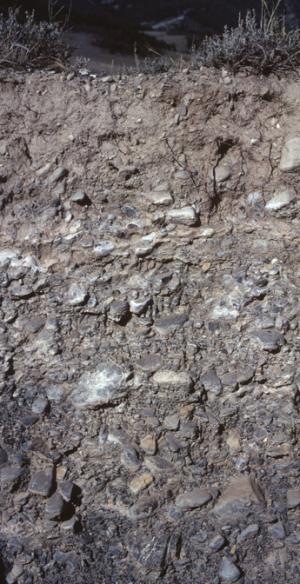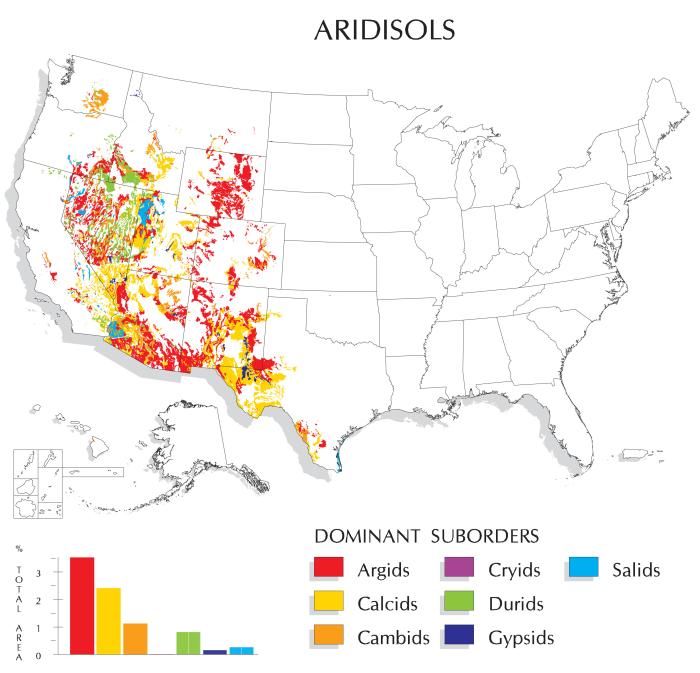Aridisols
Aridisols are soils that are too dry for the growth of mesophytic plants. They are common in the deserts of the world.

The central concept of Aridisols is that of soils that are too dry for mesophytic plants to grow. They have either:
- an aridic moisture regime and an ochric or anthropic epipedon and one or more of the following with an upper boundary within 100 cm of the soil surface: a calcic, cambic, gypsic, natric, petrocalcic petrogypsic, or a salic horizon or a duripan or an argillic horizon, or
- A salic horizon and saturation with water within 100 cm of the soil surface for one month or more in normal years.
An aridic moisture regime is one that in normal years has no water available for plants for more than half the cumulative time that the soil temperature at 50 cm below the surface is >5° C. and has no period as long as 90 consecutive days when there is water available for plants while the soil temperature at 50 cm is continuously >8° C.
Dominant Suborders
Argids
Argids have an argillic or natric horizon, but not a duripan or a gypsic, petrocalcic, petrogypsic, or salic horizon.. Most Argids are used as rangeland or wildlife habitat. Some are used as irrigated cropland.
Calcids
Calcids have a calcic or petrocalcic horizon and have calcium carbonate in the layers above. The parent materials are high in content of carbonates, or carbonates were added as dust, or both. Precipitation has been insufficient to remove the carbonates or even move them to great depths. These soils are in the Western States. Most are used as rangeland or wildlife habitat. Some are used as irrigated cropland.
Cambids
Cambids are characterized by the least degree of soil development. They are mostly in Washington State. Most are used as rangeland or wildlife habitat. Some are used as irrigated cropland.
Cryids
Cryids are the Aridisols of cold areas. They have a cryic temperature regime. The growing season is short. The short growing season and arid conditions severely limit the use of these soils. The soils are at high elevations in mountain valleys and basins in Idaho. Most of these soils are used as rangeland or wildlife habitat.
Durids
Durids are the Aridisols that have a duripan. They are in the Western States. The largest extent is in Nevada and Idaho. Most of the soils are used as rangeland or wildlife habitat. A few are used as irrigated cropland.
Gypsids
Gypsids are the Aridisols that have a gypsic or petrogypsic horizon. They are mostly in the Southwestern States. They are on many segments of the landscape. The gypsic horizon limits many soil uses. A petrogypsic horizon is an even greater limitation. Most of these soils are used as rangeland or wildlife habitat.
Salids
Salids are the Aridisols that have a salic. They are commonly in depressions (playas). They are mostly in Utah and Nevada. As a rule, Salids are unsuitable for agricultural uses unless they are leached of salts. Leaching the salts is an expensive undertaking, particularly if there is no natural outlet for the drainage water. Most of these soils are used as rangeland or wildlife habitat.

Aridisols are in the Western States. For long periods, they are too dry for mesophytic plants to grow. The concept of Aridisols is based on the limited availability of soil moisture for sustained plant growth. The redistribution and accumulation of soluble materials in some layer of the soils are common.

